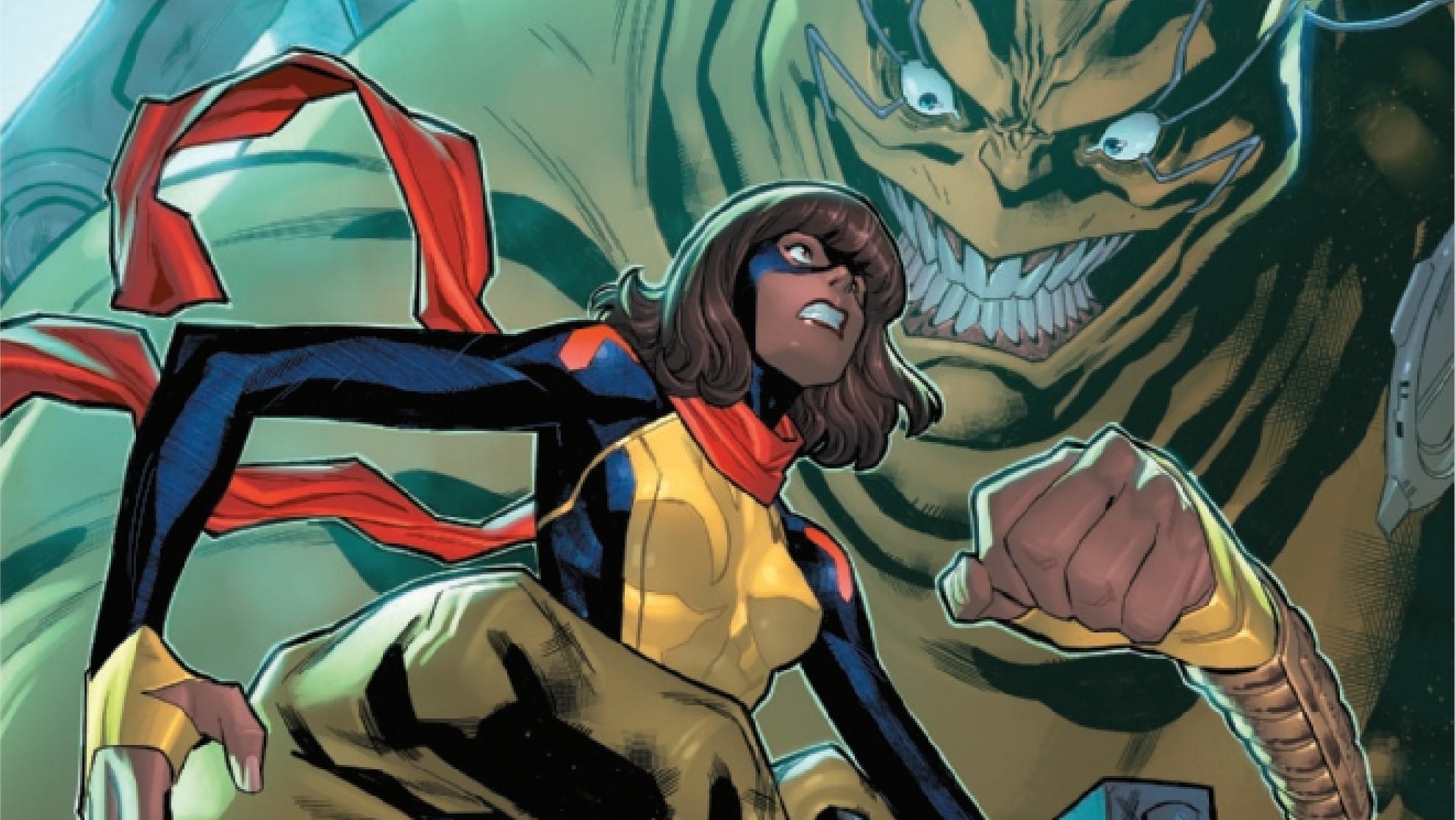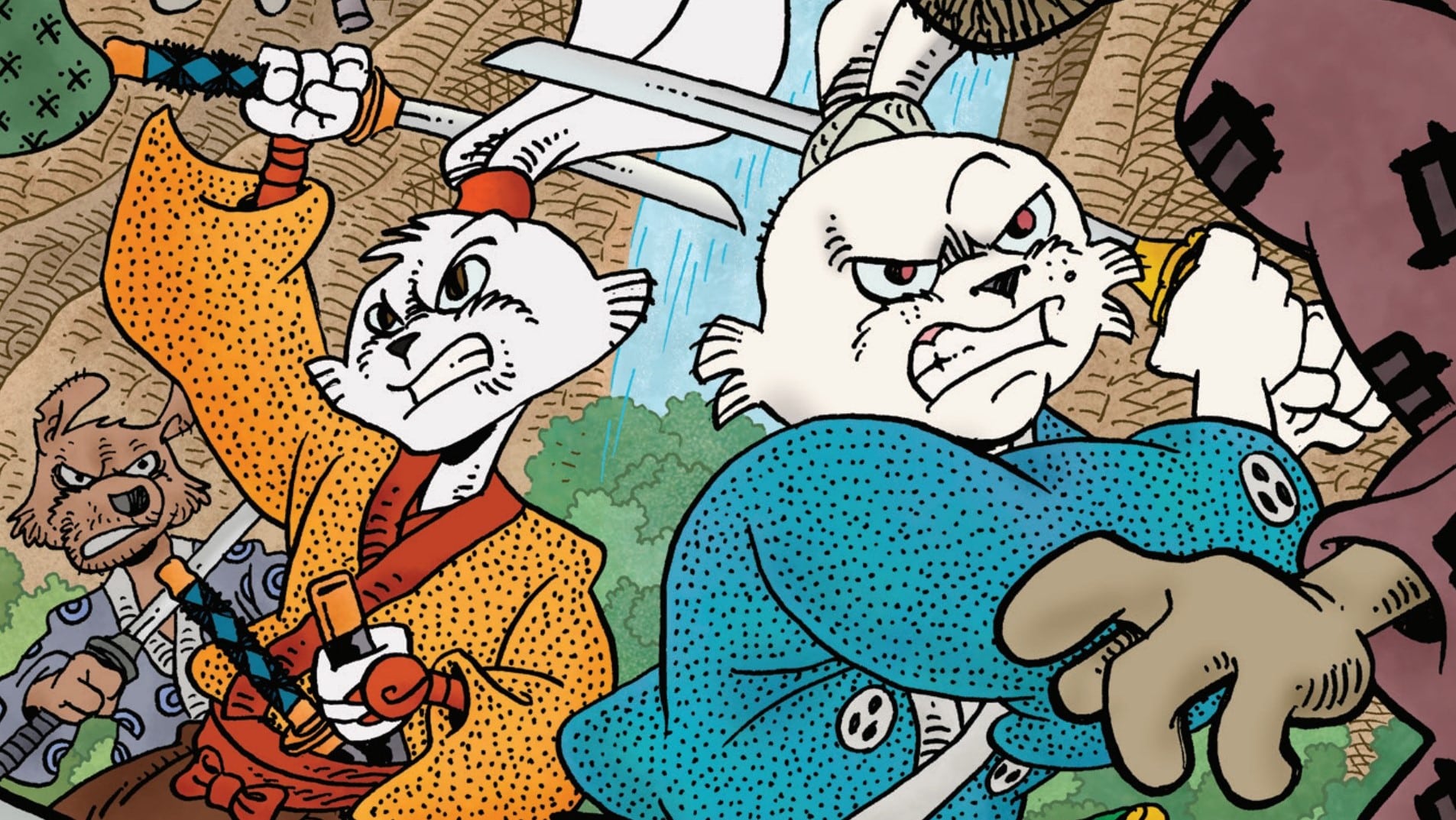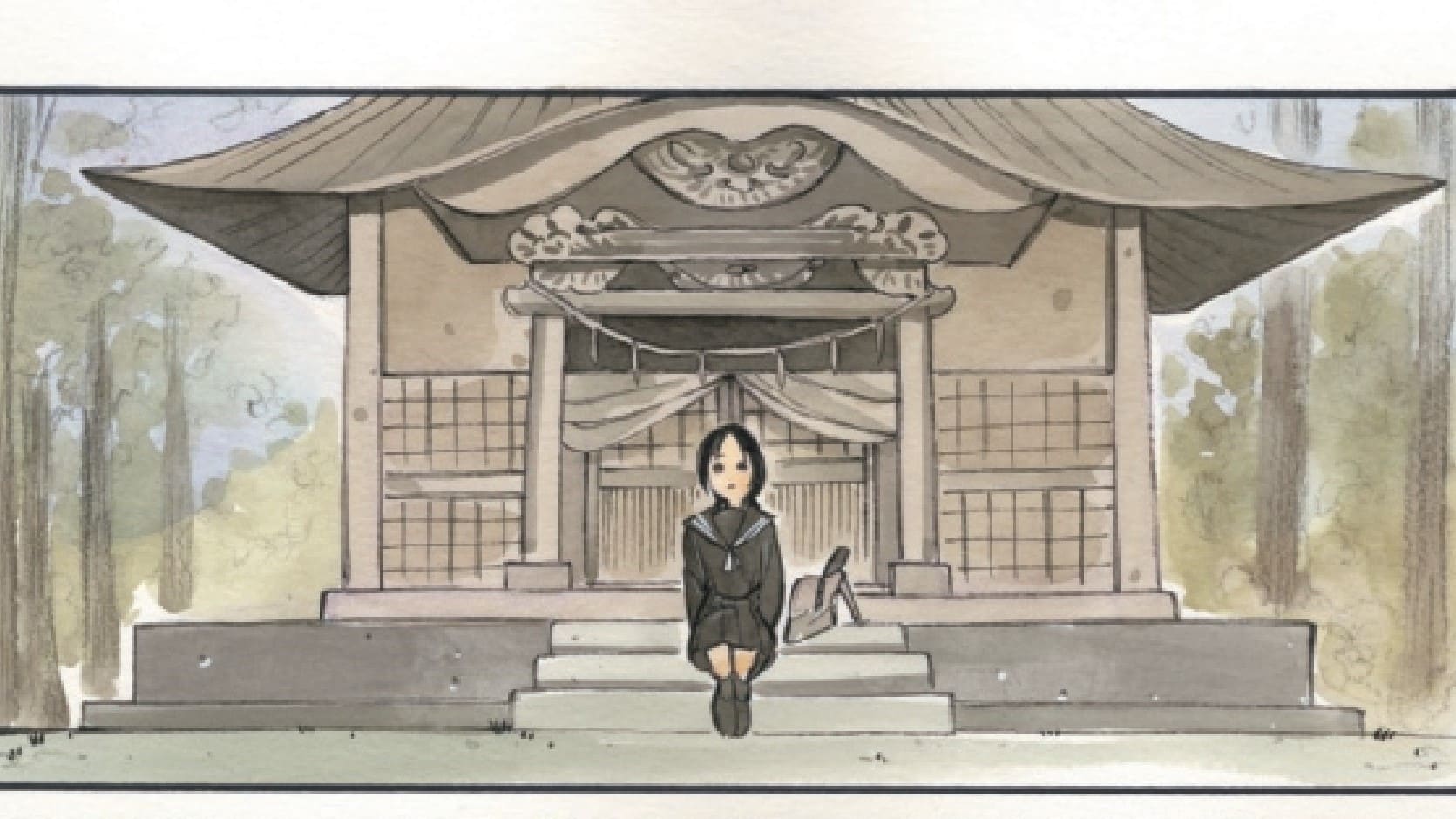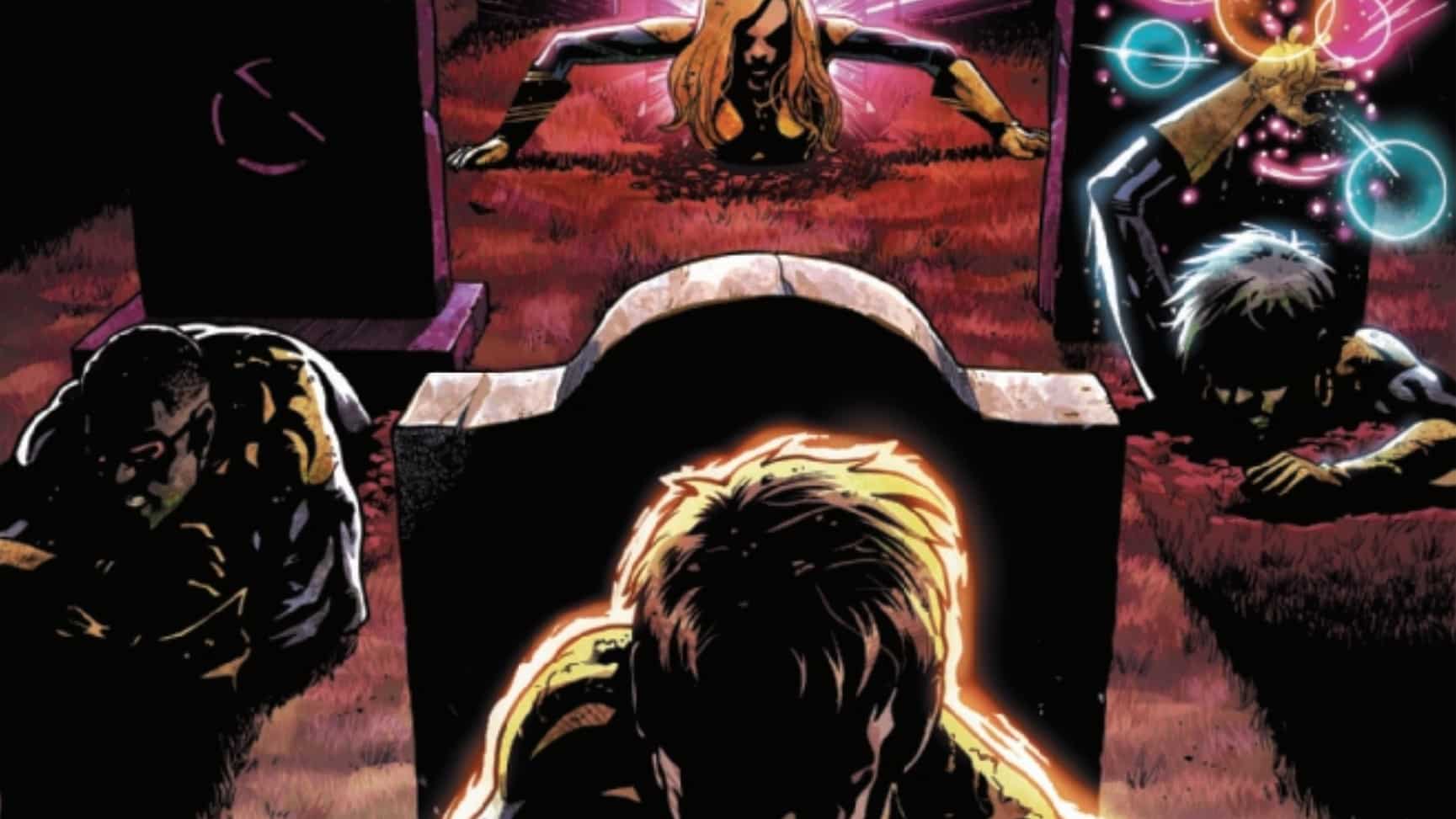The Defenders find themselves in a superhero utopia, but here’s the thing — it’s not real if it’s a dream. Defenders: Beyond #4 is brought to you by Al Ewing and Javier Rodríguez, with letters by Joe Caramagna.
Karen Charm: Dig, if you will, a picture — Defenders: Beyond is about to hit its 50th issue on the eve of The Ultimates movie premiering. You and I are getting a couple thousand dollars to talk about this milestone chapter in Ewing and Rodríguez’ epic as it re-sculpts the Marvel Universe on page and screen for decades to come. At what point do you snap out of it and realize that you’re living in a dream?
Mark Turetsky: I think the part where we get any significant amount of money for writing these. Just the thought is spooky.
No, That Can Never Be

Karen: Defenders: Beyond #4 opens with a heavily chiarascuro’d Adam Brashear in the crosshairs of a rifle scope, addressing one Lee Harvey Oswald. We are in Da’at, the Abyss, “the Land of Couldn’t-Be-Shouldn’t-Be,” which is one way to describe a superhero intervening in a historical event of this significance. There’s a Watchmen quality to seeing Blue Marvel save JFK’s life, and then running against him for president (and succeeding). This is one hell of a way to open a comic, but we quickly see what Ewing is setting up for us. To answer my opening question, you know you’re in a dream when superheroes are retiring.
Mark: To me, it brought to mind Morrison and Quitely’s The Multiversity: Pax Americana, which opens with a US president’s head exploding, and then rewinds to show you the bullet, the muzzle, the gun that fired the bullet, the assassin holding the gun: TV’s Peacemaker, demonstrating expert marksmanship while skydiving. And while it’s been a while since I’ve read The Multiversity, Defenders: Beyond #4 is definitely in conversation with some of the concepts in that text, if not with the text itself. And of course, that issue is very much a response to, if not an outright pastiche of, Watchmen, so we’re in good company on this one.
Karen: Javier Rodríguez’ style lends itself well to these kind of throwback scenarios, which I imagine is part of the reason he was hired to draw the recent History of the Marvel Universe series. He tweaks it here to make it more 60s looking, aided by pulling away from much color shading.
Mark, of course I’m going to turn to you for our monthly Kabbalah lesson, but also I’m curious if you have any idea what all the signs for “Gideon” might be trying to tell us? Is that just a thing in Dallas or is there more going on there?
Mark: Gideon is one of the capital-J Judges in The Book of Judges. He shows up at a point where the Israelites of the city of Ephrah have turned away from their god. The city is constantly raided by neighboring Midianites, and Gideon arises out of this adversity. His brothers have been killed by the Midianites, and his own father Joash has put up an altar to Baal and has planted a tree in tribute to Astarte/Asherah/Ishtar/Inanna. But Gideon (much like America in this issue) is the one who keeps faith, he decides to tear down the altar to Baal, to cut down the tree (remind you of Loki in this issue?). He won’t accept the new gods put before him because he knows the truth (plus he’s convinced by an angel creating fire out of a rock).
OR! Gideon is in reference Glorian’s real name, Thomas Gideon. One or the other. Or both? I mean, how often does someone destroy a tree that’s a god in comics?
As for Da’at, as I mentioned last time, it’s not so much a sefira as a spot where there is no sefira, but where all sefira are present in equal degrees. It’s the interstitial fluid of the universe, and here it’s the infinite possibility of what isn’t.
Karen: That’s so interesting! It’s also interesting that despite the narrative focusing on Dr. Brashear, the narrator is America Chavez. She’s musing about the American Dream as she and her long-lost sister Catalina float into panel view. This panel is extremely charming — the sisters have matching, color-swapped costumes and squared shoulders. They look happy… until the mention of their moms catches this Ms. America by surprise, and introduces doubt. Credulity is strained past breaking when Taaia and Galactus the Life-Bringer arrive, golden and beaming smiles. The whisper of “couldn’t-be-shouldn’t-be” looms all around these pages.
It’s such a well-paced reveal, as all of a sudden America has her Eternity Mask on and a creepy Glorian hovers over her shoulder. The creative team is teeing us up for the page turn, revealing a splash of the true hunger of Galactus. He’s bathed in red, underlit by blue cosmos, and his face is the picture of disease. In only six pages, Ewing and Rodríguez have crafted one hell of a jump scare.
America Chavez is fully snapped out of it, but her fellow Defenders are still caught in fitful sleep. Glorian introduces America to the Abyss, and its unique foliage. I don’t know if I’d clock those extruded shapes as trees, but as you explained, it fits the themes Ewing is playing with. Seeing Loki trapped inside one is the second big nightmare of Defenders: Beyond #4 so far.
Mark: That image of Galactus’ hunger is just incredible. It expresses so much about the character that doesn’t quite come across in Kirby’s original Giant-Stoic-Man-Who-Stands-Up-Straight. With all respect to The King, this to me expresses death and hunger, a pure expression of the metaphysical truth of Galactus, rather than his literal appearance. And before that reveal, the Kirby homages are quite strong, with Taaia flying on something very much akin to Orion’s Astro-Glider (a name I will always say, given the opportunity). It’s also playing with Ewing’s personal past with the characters; along with the Ultimates call-out, having Galactus appear in his Lifebringer form really drives home the ideas at work here. This isn’t just a comics story, it’s a story about comics. And (along with Catalina’s appearance alongside America) it’s a story about retcons and reboots.
The other thing (I mean, aside from the entire alt-hist premise being wonky from the start) that should give us pause as readers, is that this opening sequence features white panel gutters. If our interpretation of the previous issue is correct, and the white gutters represent the fires of the White Hot Room forging this comicbookical Creation, well, the Defenders have moved beyond the White Hot Room at this point. Shouldn’t the gutters represent that? And of course, when we see Da’at as it is, we get black gutters. When we return to this simulated reality, the gutters are grey.
Karen: Ooh, if you look, the margins actually get darker as you page through before settling on black again in the final third.
Crisis Aversion

Karen: It’s fascinating how Loki’s dominion over stories (pun intended) is an increasingly greater threat the further out the Defender venture. The stuff of existence is particularly malleable, I suppose. Notice how America calls Glorian a “god of lies,” too. Except Glorian wants the Eternity Mask to turn fiction to fact, to stage a “fix-it fic” and rewrite canon of that time he almost became the multiverse (presumably in Silver Surfer, according to Al Ewing’s handy reading list in the back).
Were you as grossed out by Glorian taking chunks out of himself as I was? I swear these people are writing a horror comic, happy Halloween.
Mark: I wonder, even setting aside the Eternity Mask, is America just primed to see through Glorian’s bullshit because she’s fresh off a major, character redefining retcon? Or does it come from her being a character that crosses the multiverse as a matter of course, and so has a heightened sense of who she is and what her truth is? And yes, Glorian turning bits of himself into chunks of simulacra is super gross, but in a neat way!
Karen: I do like the holes it leaves in his body.
You have to love Ewing using Taaia to get off some shots at DC and their infinite Crises. “‘Reboot after Reboot’ you said! And each sooner than the last… until not even we know if we’re the ‘true story’ — or your latest ‘maybe-verse!!!!’” Rodríguez adds a riff off of the multiple earths image made iconic by the late George Perez’ cover in case you missed the target of this dialogue. I love it, even if it’s debatable whether or not Marvel’s own approach to continuity is any better.
The Defenders’ choice of the pain of reality also seems to nod toward the tradition of Marvel’s heroes having more pain and verisimilitude to their character. It makes sense we’re getting all this now, since Ewing is essentially plotting a map of Marvel’s cosmology. As we reach the molten core, the most fundamental elements become even more apparent (look I’m not a geologist, but you know what I mean). It will be a really nice experience to read all ten issues of this Defenders run in one sitting, I think.
Mark: Yes, Glorian here really seems like he’s the personification of the Distinguished Competition. And, well, why shouldn’t he be? They’re as far away from Marvel reality as you can get, and there’s a lot of lawyers you’d have to get through to make the jump from this reality to that one, so we’ve got a cosmology that reflects a real-world conflict of IP.
The breakdown of the simulation, where simulated people become cardboard cutouts is a really great image, one that puts me in mind of a piece of media I consumed recently (but won’t reveal because it’s a huge spoiler). Suffice it to say, it turns Glorian’s ersatz reality into a carnival sideshow, or a shooting gallery. It also reminds me of the Philip K. Dick novel Time Out of Joint.
In that story, a man is unwittingly living in a simulated reality, and when he starts to be able to see through it, weird stuff starts to happen, like a soft drink stand all of a sudden gets replaced by a piece of paper that says “soft drink stand.” But really, all your brain needs to simulate something is the idea of itt, right? I can say “golf ball” and you can conjure one with your mind. Why should I bother crafting the physical object when your brain can do most of the work for me?
Karen: It’s what makes comics such a magical medium, something I think both Ewing and Rodríguez (and Caramagna, for that matter) strongly believe as well!
Ad Infinitum
Karen: Loki takes the Eternity Mask, stretches it into a condom, and slips it onto one of her horns. This is where the comic gets really fun. With a “BROOOM,” the clouds overhead break open and release the rainbow. The desaturated wasteland of the Abyss floods with brilliant color as the Queen of Nevers bursts onto the scene. God, I love this character from the days of The Ultimates, and I’m obsessed with how Rodríguez draws the rest of the comic. He’s almost certainly making visual reference to Guy Peellaert, a very groovy Belgian artist. You may recognize his work from the cover of Bowie’s Diamond Dogs, but more appropriate for this discussion is his late 60s comic Jodelle. You can see what I mean.
I’m also obsessed with the stylized word balloons that Caramagna gives her. Brightly colored text atop a white field that dissipates out in half-tone dots. And look, she’s not alone — it’s our friend Cloud!
Mark: Oh, that is some beautiful artwork, and I would not be at all surprised if that were a visual influence on Rodríguez here (or, heck, in all of his work). The Queen of Nevers, while she showed up in Ultimates, originally came from Allreds’/Slott’s Silver Surfer, a series that in a weird way served as a companion to Ultimates, as they overlapped somewhat and played in similar groovy cosmic spaces.
Here, we learn conclusively that the Pilgrim, The Fourth Cosmos, is in fact the same being as The Never Queen, which I just think is neat. Also, when Ewing and Foreman first introduced the concept of the Pilgrim back in Ultimates2 #100, they referred to the Pilgrim as “he.” Here, The Pilgrim is the Queen of Nevers, and is referred to in Silver Surfer using she/her pronouns. Has Cloud’s influence reshaped The Pilgrim to some degree and introduced a fluidity to The Pilgrim’s conception of themself?
And speaking of, yes! Cloud! I had worried that we had seen the last of Cloud in the previous miniseries. It’s awesome to see them return, and not just return, but shown to be positively thriving in their new home as one of the basic archetypes of the Marvel universe.
Karen: It feels really special to see Cloud in all their gender-expansive glory. Their whole speech made me genuinely emotional. For those of us who may see gender as an Abyss of its own at times, having a cosmic being just flip it on its head is fantastic. It doesn’t have to be “couldn’t” or “shouldn’t,” — it doesn’t have to be about fitting in the space left to you — but instead it’s “Can-Be-Shall-Be.” “Unchecked possibility is freedom.”
It’s significant this moment gets shared with with Loki of all people, who like Cloud once did flips back and forth in their presentation. Cloud continues “I’m on my journey, you’re on yours. And none of us have the map.” Even as I approach my 40s, this is the kind of thing I need to remind myself constantly, and I do appreciate the sentiment showing up in my Marvel comics. When the non-binary rep hits this good, it just convinces me that Al Ewing will always have our backs.
The Mystery will never be fully explored, the journey never ends, but there’s joy in that, not fear. Our heroes banish Glorian to his scarcity-mindset and travel onward.
Mark: And kudos to Ewing and Rodríguez for not only bringing that rep, but instilling it into the very fabric of the Marvel story; alongside Spiders, Hulks, The Four-Is-One, there stands Cloud, equal to them all.
The Pilgrim and Cloud bring our heroes to the final doorway on their journey, it’s the entrance to Keter itself, The House of Ideas. Ewing has had a lot of fun repurposing editorial elements of Marvel comics, from the titles of its anthologies to the verbal tics of its most famous editor. Keter is the highest of the sefirot. It’s absolute compassion, it is utterly incomprehensible to humankind, it’s “the most hidden of all hidden things” according to the Zohar (the group of texts that forms the foundation of Kabbalah). And The House of Ideas is the bombastic nickname that Stan Lee came up with. What a combination of concepts at work here.
Also, this isn’t the first time The House of Ideas has shown up as a concept (as the additional reading for Defenders: Beyond #4 informs us). Much of Avengers: No Road Home #9 is set within the House, so it’s worth checking it out for that alone. And yet, one would have expected that among the three writers of that story (Ewing, Mark Waid and Jim Zub) that Ewing would be the one who came up with it. Not so, according to Zub!
Karen: I did just read that story, and at the time I remember thinking “that’s definitely Kirby’s house, right?” Anyway, this final splash is another glorious piece of a glorious comic. The abstracted House of Ideas is made up of an assemblage of Kirby and Ditko graphic signifiers and Al Ewing’s favorite word (“NEXT”) scrawled across the top, made out of the original 60s logos. We’re not quite sure what the T is from but the others are Fantastic Four, Avengers, and X-Men. True Believer, we need your help!
This is such a joyful comic. As sad as I am that it’s almost over, it’s really built to last and I look forward to having it sit next to Ultimates and Immortal Hulk as an unofficial handbook to the Marvel Universe. Now, whatever questions we may have about what will be in the final issue, we are promised one question to rule them all, “The Question to All Answers.” Will we get a riff on Ditko’s Objectivism? I’m on the edge of my seat.
Mark: Maybe the question is, “What’s Next?”
Marvelous Musings
- I have a pet theory about British comics writers and the cultural significance of the JFK assassination, but I’m sure it’s hardly relegated to that group alone. (KC)
- It happened on the same day Doctor Who premiered! How could it be mere coincidence? (Well, fine, it was the next day)(MT)
- Shout-out to Tigra for getting all the cool gear.
- Boom-Boom sighting!
- We still need to resolve where this time-lost Loki ends up. Perhaps they end up alongside Stan, Jack and the whole bullpen! Excelsior! True Believers! Et cetera!







